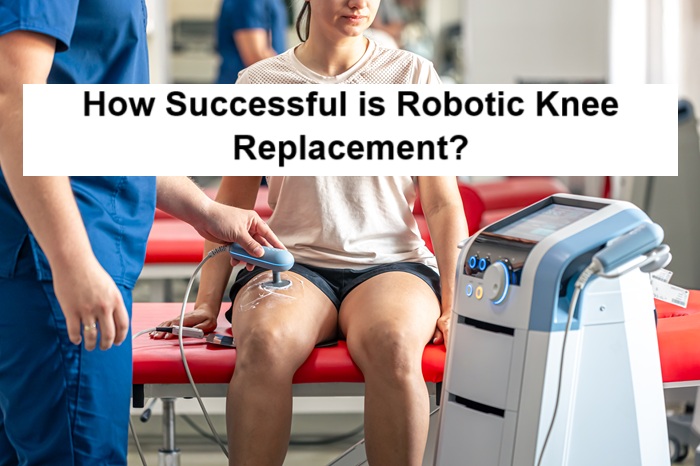Most individuals have to tolerate pain in their joints, especially their knees, without making it a topic of discussion. And your mobility, finally, your quality of life could be limited by the pain that arthritis or an injury can bring. In certain individuals, surgery is the only solution to return to normal, pain-free mobility.
Robotic knee replacement is one of the most compelling inventions, as many orthopedic technologies have evolved tremendously. So far, how successful is it, however? Is it the most preferred solution for all people, and what makes this technology so special?
Let’s examine what makes robotic knee replacement technology unique and its success rate.
What Is Robotic Knee Replacement?
We will begin by defining robotic knee replacement and discussing its success rate. It is often referred to as robotic-assisted knee replacement surgery. Robotic knee replacement is an advanced surgical technique wherein a robotic arm helps the surgeon perform a more precise knee replacement.
This does not mean, however, that the robot carries out the operation by itself. Instead, it provides the surgeon with a completely thorough 3D imaging of the knee, which aids in more accurate and personalized procedures.
The robot’s assistance includes:
- Comprehensive plan: A thorough surgical plan can be created by precisely matching your knee utilizing the pre-surgery planning tool.
- Accuracy: Aiding in the extremely exact cutting of the bone by the surgeon.
- Ligament balance and alignment: Provides the knee joint with the right balance and alignment for better post-operative results.
Why Choose Robotic Knee Replacement?
Here are the key reasons why robotic-assisted surgery is becoming more popular:
1. Better Implant Alignment
Correct implant positioning has a significant role in how your knee functions after surgery. Real-time mapping helps the robotic system to place the implant in the right place, which removes the prosthetic pressure off the knee joints and also enhances its effectiveness.
2. Faster Recovery
Robotic-assisted surgery has been reported by many patients as taking less time for recovery than conventional surgery. This means:
- Less pain after surgery.
- Return to daily activities earlier.
- Fewer limitations in the weeks following the procedure.
Patients often begin walking with minimal support within 1–2 weeks after surgery.
3. Lower Risk of Complications
Thanks to improved precision, robotic knee replacement may lower the chances of:
- Infections
- Blood clots
- Implant misalignment
- Repeat surgeries
Initial studies indicate that the patients who have undergone surgery with the help of a robotic system have minimal chances of revision surgery compared to individuals who subject themselves to traditional knee replacements.
4. Longer-Lasting Implants
The robotic surgery aids in the positioning of the knee implant in a manner that lowers the wear and tear. This is more likely to increase the hopes of the implant staying long i.e., 20 years or above based on how old the patient is, activity level, and health conditions.
Who Can Benefit from Robotic Knee Replacement?
Robotic knee replacement is suitable for people who:
- Have severe knee arthritis or joint damage.
- Have tried other treatments without relief.
- Need improved joint function for better quality of life.
It’s especially helpful for patients who are active, overweight, or have complex joint issues where alignment is key.
Success Rate of Robotic Knee Replacement
The measurement of success is normally done in pain relief, mobility, recovery status, and duration of implant life.
Research and patient results indicate:
- 90 – 95% satisfaction rate
- Lower revision rates compared to traditional surgery
- Improved joint function and more natural movement
- Faster return to walking and daily routines
What to Expect During Recovery
Recovery from robotic knee replacement varies by individual, but many people experience:
- Walking with support within a few days.
- Physical therapy starts soon after surgery.
- Returning to regular daily activities in 4 – 6 weeks.
- Full recovery and strength building over several months.
Some tips for speedy recovery:
- Strictly follow the plan of your physical therapist.
- Use ice to lessen swelling.
- Stay active with guided movements.
- Wear comfortable, supportive shoes.
- Take rest when needed and avoid overexertion.
Risks and Considerations
Although robotic knee replacement is a very safe procedure, there are some sort of risks involved, like any other surgery, such as:
- Bleeding or infection
- Blood clots
- Allergic reaction to anesthesia
- Rarely, implant issues
It’s important to discuss your full medical history with your surgeon to decide if robotic surgery is right for you. You can get the best robotic knee replacement surgeon in Delhi easily for the best results.
Is Robotic Knee Replacement Right for You?
Not everyone needs robotic-assisted surgery, but it can be especially helpful for people who:
- Want better accuracy and faster healing
- Have had trouble with previous knee treatments
- Are active and want a durable, long-term solution
Your doctor will guide you based on your condition, age, activity level, and joint health. When it comes to cost, the robotic knee replacement cost depends on the severity and the expertise of the surgeon.
Final Thoughts
Robotic knee replacement surgery is very successful and a bright move in joint surgery. It has a lot of advantages than the traditional approaches, considering its better rate of accuracy, reduced times of recovery, and higher satisfaction rates.
Although it is not essential in every case, it is worth checking out, particularly in case you are having difficulties with knee pain that is not getting any better as you seek treatment.
Always consult a qualified orthopedic specialist to evaluate your condition and help you make the best choice for your joint health and future mobility.

Nice post